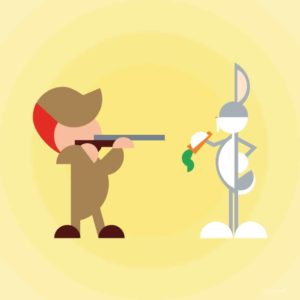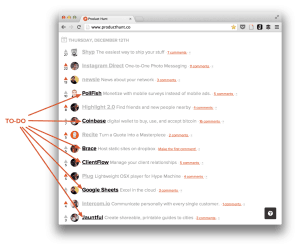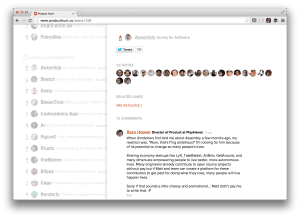
Recently, Nathan Bashaw and I launched Product Hunt, a daily leaderboard of the best new products. As two product enthusiasts, we wanted to create a community to share, discover, and geek out about new and interesting products. But to make it a success, we knew we had to make it a habit, a product people would use every day.
Early feedback suggests it’s been working, as gauged by several tweets and our own site traffic analysis. Qualitative feedback is great, of course, but what people actually do is more important.
- 60% of daily active users (DAU) are returning visitors
- 32% of unique visitors in the past week have visited the site 5 or more times
- 52% of subscribers open daily email digest (yes, daily!) and 23% click-through
This is especially encouraging, considering the site’s minimalism and lack of obvious re-engagement features. Here are the design decisions and strategies used to build a habit-forming product, largely influenced by Nir Eyal’s work.
Build for Existing Behaviors
In a recent interview, Ev Williams, founder of Blogger, Twitter, and Medium, shared his strategy for building a billion-dollar business:
Take a human desire, preferably one that has been around for a really long time… identify that desire and use modern technology to take out steps.
Product Hunt isn’t attempting to create new desires or behaviors. We are providing people with a destination to do something they already do. Most successful startups begin this way.
People have been sharing and beautifying photography for decades. Instagram made this effortless and more accessible.
Sharing links and updates across social networks was a daily habit for many before Joel Gascoigne, founder of Buffer, scratched his own itch to make this even easier and more efficient.
As social networks increase the speed and frequency of link-sharing, people have become inundated with articles. Nate Weiner emailed himself links – an inefficient and terrible way to save articles. And he wasn’t the only one as his bookmarking service, Pocket (formerly Read-It-Later) solves this problem for millions others.
Similarly, Product Hunt’s inspiration comes from our own desires and observations of existing user behaviors.
New products are newsworthy and a topic of conversation. “What new apps are you using? What’s on your iPhone home screen? Did you see that new product announcement?” Product releases and significant feature updates also drive attention to popular publications like Techcrunch.
These conversations also exist in online communities like Hacker News. “Show HN” is a popular meme where product creators share their weekend hacks and product launches with the community. These posts often receive a lot of attention as users upvote and engage in discussion with the founders.
But these behaviors exist outside of the tech, early adopter crowd. Every Thursday, the Apple App Store features new and interesting apps, driving hundreds of thousands of downloads daily. For many, exploring featured apps is a weekly ritual. Kickstarter has also proven there is mainstream interest in discovering and sharing (and even backing!) cool, new products.
Product Hunt is the destination for these conversations and desires.
Remind Users to Return
Habits don’t form overnight. It takes several days, often weeks for a product or service to earn unprompted user engagement, triggered by people’s day-to-day emotions. Consider your use of Facebook, Twitter, Pinterest, or other popular, habit-forming products. Engagement starts with external triggers that inform the user what to do, driving the desired behavior.
Immediately after signing up on Twitter, the service recommends users to follow. Soon after, email notifications are sent to the user, highlighting tweets from those followed. Companies promote their @username through TV commercials, billboards, online advertising, and even their own business card. Friends and colleagues talk about breaking news they discovered on Twitter. All of these external triggers – directly or indirectly delivered by Twitter – re-engage users.
This sounds obvious and some argue companies are too aggressive with external triggers (and some are), but it’s important to realize your startup is of very little interest (at least initially) to others. Users are inundated with the distractions of everyday life – they need and want to be reminded you exist.
Product Hunt uses the following external triggers to re-engage users:
1) Daily Email Digest
Every morning, yesterday’s top 3 products arrive in subscribers’ email inbox. For many, this is the product, delivering users a brief, scannable digest of what the community thinks is neat. At the bottom of the email, a large button prompts the user to view more products submitted the previous day.
2) Twitter
Each product submission is tweeted by @producthunt, attributing the user that submitted it.
Timely: The time tracking app to end time tracking https://t.co/NaWGBaMAPF via @hnshah on @producthunt https://t.co/cJLb1EKZFo
— Product Hunt (@producthunt) December 15, 2013
This extends Product Hunt beyond email and the site itself to another communication channel. Submitters receive feedback for their contribution, @producthunt followers are reminded of the service, and often founders of the products shared discover the service after monitoring mentions of their product on Twitter.
3) Product Launches
Product Hunt is a celebration of new products. Every day, new web apps, games, creative hacks, and hardware products are unveiled to the world, grabbing our attention through news feeds and online publications. When this occurs, Product Hunt users know where to turn to submit their new discovery and discuss with likeminded people. Product press and attention effectively becomes an external trigger to visit Product Hunt. Wonderful, isn’t it?
4) Products Used
But arguably the most powerful and long-lasting external trigger are the products discovered on Product Hunt. Several people have told me how much they love Momentum, appreciative that they found it on Product Hunt. After installing the Momentum Chrome extension, the service replaces the new tab with a new beautiful photo each day, prompting the user to enter their main focus for the day. It serves as a to-do list, embedding itself into people’s daily routine (consider how often you hit cmd+t in your browser). In turn, Momentum becomes an external trigger for our service, reminding users Product Hunt is the place to discover great products.
Find an Internal Trigger
External triggers such as email notifications and word-of-mouth are an important drive of re-engagement but they are not the only thing that brings users back. Internal triggers are where habits are formed. These triggers form within one’s thoughts, often coupled with emotions, particularly those that are negative. When negative feelings arise, users seek resolution, turning to products or services that alleviate the “pain.”
FOMO (fear of missing out) is a form of social anxiety. We all want to stay up-to-date and knowledgeable about what’s new and happening. Some may even feel embarrassed by their lack of understanding of particular events or topics. This is certainly true in politics and news but also for products.
Product Hunt alleviates this FOMO, providing a quick digest of new and interesting products. Visitors leave the site reassured that they’re up-to-date and familiar enough with the latest products to say, “Yes, I know about .” at the next social gathering.
Make it Enjoyable to Create and Consume
The initial Product Hunt prototype offered contributors a free-form text field to include a description with each product submitted. Some users provided lengthy narratives of the product. Others didn’t include a description at all. To make Product Hunt compelling, scannable, and more fun, we added constraints, taking inspiration from AngelList’s startup taglines.
In addition to the product name and link, contributors must include a short tagline for the product. Contributors can copy and paste the tagline used on the product’s landing page or create their own. For example:
- Mindie: Create 7-Second Music Videos
- Hatch: The app that loves you back
- Blue Goji: Gamified Exercise Equipment
- BloomTHAT: Ridiculously Fast Flowers
- Keezy: Turn your phone into an instrument
It’s fun to come up with a tagline – to think creatively and artistically describe a product to the world. Similar to Twitter, limiting taglines to 65 characters forces succinctness, making creation more accessible and consumable.
This small amount of effort also establishes ownership of the submission. When visitors upvote the product, contributors receive recognition not only for their discovery but also for their efforts describing the product via a tagline.
Let the User Win

Communities like Hacker News and Reddit rank user submissions using an algorithm based on the number of votes and other factors. Posts rise and fall in the ranks, creating a fluid, ever-changing homepage of the best new content. Product Hunt takes a different approach, grouping submissions by day, ranked by the total number of votes. This unique presentation reduces the anxiety of consuming a seemingly never-endless feed of content. Each day serves as a finish line, giving users the ability to quickly scan through products posted today, yesterday, and previous days.
Of course, as the community grows, more products are submitted each day. Some people informed us that they found it difficult to parse the product names to find new additions added since their previous visit earlier in the day. So we made a super simple addition to the CSS:
a:visited {color:#bbb}After clicking the product name, it changes from black to gray to identify products previously viewed. This also turns the feed into a to-do list, encouraging visitors to click on more products and achieve “completion.”
Reduce Friction

Discussion is a critical component to Product Hunt. Although not everyone has permission to comment yet, those that do are far more engaged as they revisit the site to read and respond throughout the day. To encourage conversation, we knew we needed to make it easy for users to view the discussion without sacrificing the clean, easy to consume homepage.
Our solution: the “Bashaw Pane,” named after my partner Nathan Bashaw. With a single click, the discussion dynamically slides in from the right without navigating to an entirely new page. The homepage remains visible on the left, making it easy for users to return to the feed without losing context. By reducing friction, visitors consume and contribute more.
This presentation is also used when directly navigating to the discussion, teasing new and interesting product discoveries on the left side of the page. This helps on-board new users that find Product Hunt through links shared on Twitter and elsewhere.
Make it Unpredictable
Unlike most directories, Product Hunt avoids categorizing products to encourage serendipitous discovery. Although most submissions are technology products, occasionally the delightful and unexpected product is submitted. Last week a Tuft & Needle, a new startup offering boutique-quality beds at an affordable price, was shared. Rarely would I seek a new bed but this unexpected find and AMA with its founders, was enjoyable.
As previously mentioned, Product Hunt subscribers receive an email each morning with the top three products voted by the community. The daily digest is delightful because of its variability. Subscribers know that it is coming but they don’t know what it will contain. “Which new, interesting products will I discover? Did the product I submitted make it to the top?” Curiosity is what drives people to open and read.
But even more unpredictable are the announcements included at the top of the digest highlighting founder AMA’s, announcing breaking product launches, or prompting users to submit a screenshot of their mobile device home screen for an upcoming blog post. Every day is different.
Use the Right Language
Copy is often the last thing product builders work on. Our initial tagline was, “Product Hunt is for product people,” describing the type of community we’re targeting and eliciting curiosity. That was a bad idea. It was too vague and didn’t describe the purpose of the site. So we changed it to:
The daily leaderboard for new products
Let’s break this down:
- “Daily” frames the habitual behavior we’re seeking to facilitate.
- “Leaderboard” implies a ranking and system of curating the best.
- “New products” communicates the type of submissions accepted
Although it’s too early to tell if we’ve built a long-lasting, habit-forming product, early signs are encouraging. And it all comes down to smart design, which we hope we have attained.
Note: This guest post was written by Ryan Hoover
Photo credit: Mark Gilmour
Related Articles
- Schedule Maker: a Google Sheet to Plan Your Week
- The New York Times Uses the Very Dark Patterns it Derides
- How to Start a Career in Behavioral Design
- A Free Course on User Behavior
- User Investment: Make Your Users Do the Work
- Variable Rewards: Want To Hook Users? Drive Them Crazy
- The Hooked Model: How to Manufacture Desire in 4 Steps
